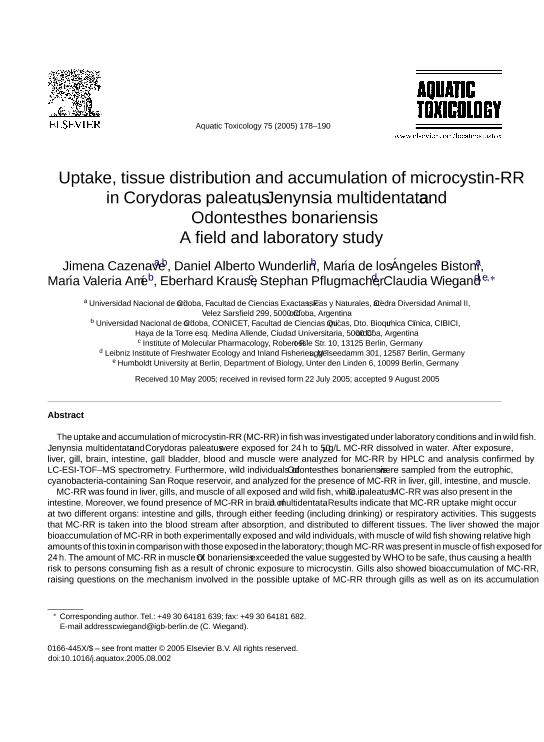Mostrar el registro sencillo del ítem
dc.contributor.author
Cazenave, Jimena

dc.contributor.author
Wunderlin, Daniel Alberto

dc.contributor.author
Bistoni, Maria de Los Angeles

dc.contributor.author
Amé, María Valeria

dc.contributor.author
Krause, Eberhard
dc.contributor.author
Pflugmacher, Stephan
dc.contributor.author
Wiegand, Claudia
dc.date.available
2020-04-13T15:32:44Z
dc.date.issued
2005-10
dc.identifier.citation
Cazenave, Jimena; Wunderlin, Daniel Alberto; Bistoni, Maria de Los Angeles; Amé, María Valeria; Krause, Eberhard; et al.; Uptake, tissue distribution and accumulation of microcystin-RR in Corydoras paleatus, Jenynsia multidentata and Odontesthes bonariensis; Elsevier Science; Aquatic Toxicology; 75; 2; 10-2005; 178-190
dc.identifier.issn
0166-445X
dc.identifier.uri
http://hdl.handle.net/11336/102367
dc.description.abstract
The uptake and accumulation of microcystin-RR (MC-RR) in fishwas investigated under laboratory conditions and in wild fish. Jenynsia multidentata and Corydoras paleatus were exposed for 24 h to 50 µg/L MC-RR dissolved in water. After exposure, liver, gill, brain, intestine, gall bladder, blood and muscle were analyzed for MC-RR by HPLC and analysis confirmed by LC-ESI-TOF–MS spectrometry. Furthermore, wild individuals of Odontesthes bonariensis were sampled from the eutrophic, cyanobacteria-containing San Roque reservoir, and analyzed for the presence of MC-RR in liver, gill, intestine, and muscle. MC-RR was found in liver, gills, and muscle of all exposed and wild fish, while in C. paleatus MC-RR was also present in the intestine. Moreover, we found presence of MC-RR in brain of J. multidentata. Results indicate that MC-RR uptake might occur at two different organs: intestine and gills, through either feeding (including drinking) or respiratory activities. This suggests that MC-RR is taken into the blood stream after absorption, and distributed to different tissues. The liver showed the major bioaccumulation of MC-RR in both experimentally exposed and wild individuals, with muscle of wild fish showing relative high amounts of this toxin in comparison with those exposed in the laboratory; thoughMC-RRwas present in muscle of fish exposed for 24 h. The amount of MC-RR in muscle of O. bonariensis exceeded the value suggested by WHO to be safe, thus causing a health risk to persons consuming fish as a result of chronic exposure to microcystin. Gills also showed bioaccumulation of MC-RR, raising questions on the mechanism involved in the possible uptake of MC-RR through gills as well as on its accumulation in this organ. Although MC-LR has been reported in brain of fish, this is the first report confirming the presence of MC-RR in this organ, which means that both toxins are able to cross the blood–brain barrier. These findings also raise questions on the probable neurotoxicity of microcystins.
dc.format
application/pdf
dc.language.iso
eng
dc.publisher
Elsevier Science

dc.rights
info:eu-repo/semantics/openAccess
dc.rights.uri
https://creativecommons.org/licenses/by-nc-sa/2.5/ar/
dc.subject.classification
Otras Ciencias Biológicas

dc.subject.classification
Ciencias Biológicas

dc.subject.classification
CIENCIAS NATURALES Y EXACTAS

dc.title
Uptake, tissue distribution and accumulation of microcystin-RR in Corydoras paleatus, Jenynsia multidentata and Odontesthes bonariensis
dc.type
info:eu-repo/semantics/article
dc.type
info:ar-repo/semantics/artículo
dc.type
info:eu-repo/semantics/publishedVersion
dc.date.updated
2020-04-13T13:14:54Z
dc.journal.volume
75
dc.journal.number
2
dc.journal.pagination
178-190
dc.journal.pais
Países Bajos

dc.journal.ciudad
Amsterdam
dc.description.fil
Fil: Cazenave, Jimena. Consejo Nacional de Investigaciones Científicas y Técnicas. Centro Científico Tecnológico Conicet - Santa Fe. Instituto Nacional de Limnología. Universidad Nacional del Litoral. Instituto Nacional de Limnología; Argentina
dc.description.fil
Fil: Wunderlin, Daniel Alberto. Consejo Nacional de Investigaciones Científicas y Técnicas. Centro Científico Tecnológico Conicet - Córdoba. Instituto de Ciencia y Tecnología de Alimentos Córdoba. Universidad Nacional de Córdoba. Facultad de Ciencias Químicas. Instituto de Ciencia y Tecnología de Alimentos Córdoba; Argentina
dc.description.fil
Fil: Bistoni, Maria de Los Angeles. Universidad Nacional de Córdoba. Facultad de Ciencias Exactas, Físicas y Naturales. Cátedra de Diversidad Animal I; Argentina
dc.description.fil
Fil: Amé, María Valeria. Consejo Nacional de Investigaciones Científicas y Técnicas. Centro Científico Tecnológico Córdoba. Centro de Investigaciones en Bioquímica Clínica e Inmunología; Argentina
dc.description.fil
Fil: Krause, Eberhard. Institute of Molecular Pharmacology; Alemania
dc.description.fil
Fil: Pflugmacher, Stephan. Leibniz Institute of Freshwater Ecology and Inland Fisheries; Alemania
dc.description.fil
Fil: Wiegand, Claudia. Leibniz Institute of Freshwater Ecology and Inland Fisheries; Alemania
dc.journal.title
Aquatic Toxicology

dc.relation.alternativeid
info:eu-repo/semantics/altIdentifier/url/https://www.sciencedirect.com/science/article/abs/pii/S0166445X05002602
dc.relation.alternativeid
info:eu-repo/semantics/altIdentifier/doi/http://dx.doi.org/10.1016/j.aquatox.2005.08.002
Archivos asociados
